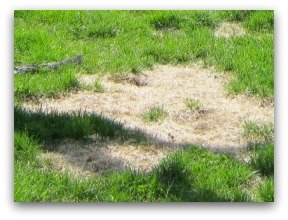Lawn Problems
Dealing with lawn problems can be challenging, and sometimes our budgets just don't allow us to hire an expert. Ripping up your yard, and replacing it with new sod or seed, is not the only option.
However, lawn repair may not always be as simple as do-it-yourselfers would like it to be. It often takes hard work and understanding to repair, or renovate an existing lawn.
To build an environment that makes your lawn thrive for years, takes knowledge, time, and patience.
This module will first cover some lawn problems, then soil problems. From there, we will look at options of whether you will be repairing lawn, or renovating lawn. This will depend on your existing problem.
Doing the work yourself can save you a substantial amount of money, so you should commit some time into reading and understanding the information provided. The reward is “dollars saved”, the cost is your “time investment”.
Are you a perfectionist, or do you just want something green over your dirt?
For those of you looking for a quick fix, buy a bag of grass seed, spread it around, and water it. It can't be more simple than that. (This has been known to work on occasion). We have a whole module on Seeding if this is what you want to do.
Or maybe you already tried that, and now you want to look at other options? Who knows, but we do have a ton of tips, and helpful information in this series.
The first thing you need to know is, why you are having lawn problems. Do you have a lot of lawn weeds? Do you have poor soil? Did you mow, fertilize, and water it properly? Do you have dead grass patches from heavy foot traffic? Do you have areas of winter kill? Do you have patchy grass from dog burns in your lawn? Has it been badly neglected?
Understanding why your lawn is in poor condition, is the key to avoiding issues in the future. learn how to build a healthy lawn that will stand up to the stresses that man, and mother nature will put it through. If you don't, you may be back here sooner than you think.
There are different options on how to renovate an existing lawn. Every situation is different, so read through the whole module before you decide on the best lawn repair method for you. It will be based on your climate, region, grass type, your budget, and how much work you are willing to do.
It is also possible there may be no quick fix at all. For example, poor drainage and regrading can sometimes be a little more than the do-it-yourselfer can handle.
Because of the scope of this material, it just isn't possible to cover everything you may encounter or need to know in this module. (There are complete books written about some of these topics). This means we will also have some helpful links to more specialized sites when dealing with diseases, insects, or soil.
Herbicides, fungicides, and pesticides, can be damaging to your lawn, the environment, and health of children and pets.
These should not be applied unless you fully understand what they are, how they are applied, and how they affect your lawn and soil.
You are also responsible for knowing your local by-laws regarding chemical use. We have seen more and more restrictions places on chemical use over the past few years.
It's important to understand the type of grass that you have, and what requirements will keep it thriving. There are many different varieties of grass, and they sometimes have special needs.
To open a separate window to learn more about grass types, please visit our friends at The Lawn Care Academy for further information.
Grass may have been around the planet for about 20 million years, but it does have a life cycle. It starts from seed, and a healthy lawn needs to be in a constant state of reproduction. This is why people over seed their lawn and top dress each year. Maintaining a thick lawn will help eliminate many lawn problems. New grass should always be introduced as the old grass dies.
I have seen people over the years follow the lawn care advice of a neighbor, friend, or even a co-worker. They will often be frustrated when they try the same methods, but don't get the same positive results.
Your neighbor could have a different variety of grass, or a completely different soil composition. What may work for him, may not work for you.
It's true they may live next door, but their soil may have come from 30 miles north of the city, and yours may have come from 30 miles south. This can change things dramatically. This is why "You" need to understand your own soil, grass, and maintenance techniques.
If you feel there is anything that we can change, modify or add to this module, please let us know. At Dream-yard we always encourage professionals, and homeowners to write in with their tips and techniques.
We would also love to hear about the positive and negative things that you encounter during your projects. This allows us to improve our reference material for everyone's benefit.
If you have any questions along the way you can contact us by using the contact us page.
If you have pictures, links, or videos related to this module, we would be happy to consider adding them as well. All credit will be given to the owner of any material displayed on this site. Helpful related links will be posted in, and at the end of the module.
So lets get to it. Below is a layout of the module with the links for each one at the bottom of each page.
Let's get started with Grass Problems.
The Dream-yard Team.
______________________________________
Table of Contents: Lawn Problems
C. Lawn Repair
E. Replace Lawn
H. How to Sod
______________________________________
Check out our time and money saving e-book
How to avoid the biggest mistakes made by DIYers, designers, and landscaping companies.
Visitor
Favorites
Giggles 'n' Thoughts







